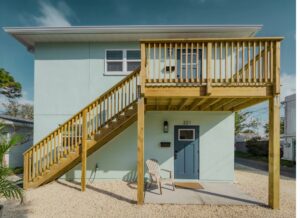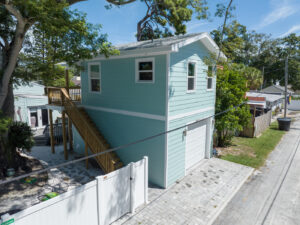Thinking about owning a tiny home? Accessory Dwelling Units (ADUs – or tiny homes) are known for their affordability, offering homeowners a cost-effective way to expand living space or generate rental income while enhancing property value. However, it’s important to recognize that while ADUs are a cost-effective housing option in the long run, constructing one can still represent a substantial upfront investment.
A few things to know when thinking about building a tiny home:
- The average cost of an ADU in Florida is between $150k – $300k
- In the St. Petersburg area, an ADU can generate approximately $35,000 in gross annual income.
- Homes with an ADU are priced 35% higher on average than a home without one
From architectural designs and permitting fees to construction, the cost of building an ADU requires a financial commitment that may not be immediately offset by rental income. The return on investment (ROI) from ADUs typically accumulates over time, making it essential for homeowners to plan for the initial expenses while considering the long-term financial benefits and added property value that ADUs can bring.
Now, let’s delve into how the government’s new lending rule changes can not only alleviate the upfront investment concerns but also further enhance the financial viability of ADUs.
FHA’s Vision for Affordable ADUs
The Federal Housing Administration (FHA) has recently approved a Mortgagee Letter that revolutionizes the world of ADU construction.
The changes allow homeowners to count projected rent from ADUs toward their qualifying income for loans. This groundbreaking move has a significant impact on making ADU construction more affordable for countless homeowners.
The Previous Scenario
Homeowners faced several challenges when it came to financing ADU construction. The FHA did not permit borrowers to include potential rental income from an ADU when qualifying for a loan to build one, or when seeking a loan on a property that already has an ADU. This limitation made it difficult for individuals to embark on ADU construction projects, hindering the growth of this vital housing solution.
The New Policy Changes
The new policy changes by the FHA can alleviate these financial hurdles significantly. Borrowers are able to use projected rental income from an ADU to help them qualify for an FHA loan. This change applies when purchasing a home with an existing ADU and when seeking an FHA 203(k) renovation loan to build an ADU on property they already own.
In essence, homeowners are now able to tap into the income potential of their ADUs to make their dreams of ADU construction a reality!
ADU Financing Revolution
The changes by the FHA represent a significant step forward in making ADU construction more affordable and accessible for homeowners across the country. By allowing borrowers to count projected rental income from ADUs in loan qualification, the FHA is paving the way for a brighter future for ADUs and the housing industry as a whole.
Benefits of the FHA Changes:
- Increased Affordability: By allowing borrowers to count projected rental income, the FHA will empower more individuals to invest in ADU construction. This increase in demand for ADUs could potentially drive down construction costs, making it more affordable for everyone.
- Improved Financing Options: FHA financing is known for its flexibility and accessibility. Allowing ADU rental income to be part of the financing process means more homeowners can access the funds they need to build or renovate ADUs, without the need for exorbitant loans or high-interest rates.
- Enhanced Access to ADUs: Accessory Dwelling Units have the potential to address housing shortages and provide sustainable housing solutions. With these proposed changes, more people will have the opportunity to build ADUs, contributing to the overall availability of affordable housing.
- Alignment with Industry Trends: The FHA’s move to allow ADU rental income in the financing process aligns with the broader trend of recognizing the value of ADUs in addressing housing challenges. This change puts the FHA at the forefront of supporting innovative housing solutions.
ADU Financing Options
ADU financing options have evolved significantly in recent years, offering homeowners diverse pathways to fund their tiny home projects. Traditional financing routes such as personal savings, home equity loans, or refinancing remain viable choices.
Additionally, specialized ADU financing programs have emerged, including ADU-specific loans and construction-to-permanent financing options. These tailor-made solutions often feature competitive interest rates and flexible terms, making it easier for homeowners to embark on ADU construction projects without straining their finances.
If you’re looking for payment options, we’ve got your back! We work with awesome lenders to make financing a breeze.
- Cash
- Personal Loan
- Home Equity Line of Credit
- Home Improvement Loan
- Homestyle Renovation Loan
- Construction Loan
Exploring these various financing avenues enables homeowners to select the option that best aligns with their financial goals and circumstances, ultimately facilitating the growth of ADUs as a housing solution.
At CASK Construction, we are excited about these changes and are committed to supporting homeowners in their ADU construction journey. As these developments unfold, we will continue to provide guidance, expertise, and high-quality construction services to help you bring your ADU project to life.
Together, we can make affordable and sustainable housing a reality for all.






